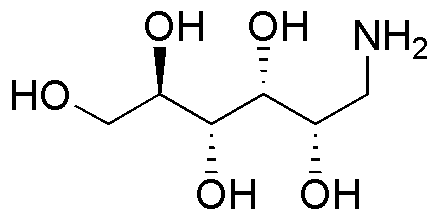D-Glucamine is widely utilized in research focused on:
- Pharmaceutical Formulations: It serves as an excipient in drug formulations, enhancing solubility and stability, which is crucial for effective delivery of active ingredients.
- Biochemical Research: Used as a reagent in various biochemical assays, it helps in studying enzyme activities and metabolic pathways, providing insights into cellular functions.
- Diagnostic Applications: D-Glucamine is employed in the development of contrast agents for medical imaging, improving the visibility of tissues and organs during scans.
- Food Industry: It acts as a sweetener and stabilizer in food products, offering a low-calorie alternative that meets consumer demand for healthier options.
- Cosmetic Formulations: Its moisturizing properties make it a valuable ingredient in skincare products, enhancing hydration and skin texture, appealing to the beauty industry.
General Information
Properties
Safety and Regulations
Applications
D-Glucamine is widely utilized in research focused on:
- Pharmaceutical Formulations: It serves as an excipient in drug formulations, enhancing solubility and stability, which is crucial for effective delivery of active ingredients.
- Biochemical Research: Used as a reagent in various biochemical assays, it helps in studying enzyme activities and metabolic pathways, providing insights into cellular functions.
- Diagnostic Applications: D-Glucamine is employed in the development of contrast agents for medical imaging, improving the visibility of tissues and organs during scans.
- Food Industry: It acts as a sweetener and stabilizer in food products, offering a low-calorie alternative that meets consumer demand for healthier options.
- Cosmetic Formulations: Its moisturizing properties make it a valuable ingredient in skincare products, enhancing hydration and skin texture, appealing to the beauty industry.
Documents
Safety Data Sheets (SDS)
The SDS provides comprehensive safety information on handling, storage, and disposal of the product.
Product Specification (PS)
The PS provides a comprehensive breakdown of the product’s properties, including chemical composition, physical state, purity, and storage requirements. It also details acceptable quality ranges and the product's intended applications.
Certificates of Analysis (COA)
Search for Certificates of Analysis (COA) by entering the products Lot Number. Lot and Batch Numbers can be found on a product’s label following the words ‘Lot’ or ‘Batch’.
*Catalog Number
*Lot Number
Certificates Of Origin (COO)
This COO confirms the country where the product was manufactured, and also details the materials and components used in it and whether it is derived from natural, synthetic, or other specific sources. This certificate may be required for customs, trade, and regulatory compliance.
*Catalog Number
*Lot Number
Safety Data Sheets (SDS)
The SDS provides comprehensive safety information on handling, storage, and disposal of the product.
DownloadProduct Specification (PS)
The PS provides a comprehensive breakdown of the product’s properties, including chemical composition, physical state, purity, and storage requirements. It also details acceptable quality ranges and the product's intended applications.
DownloadCertificates of Analysis (COA)
Search for Certificates of Analysis (COA) by entering the products Lot Number. Lot and Batch Numbers can be found on a product’s label following the words ‘Lot’ or ‘Batch’.
*Catalog Number
*Lot Number
Certificates Of Origin (COO)
This COO confirms the country where the product was manufactured, and also details the materials and components used in it and whether it is derived from natural, synthetic, or other specific sources. This certificate may be required for customs, trade, and regulatory compliance.


